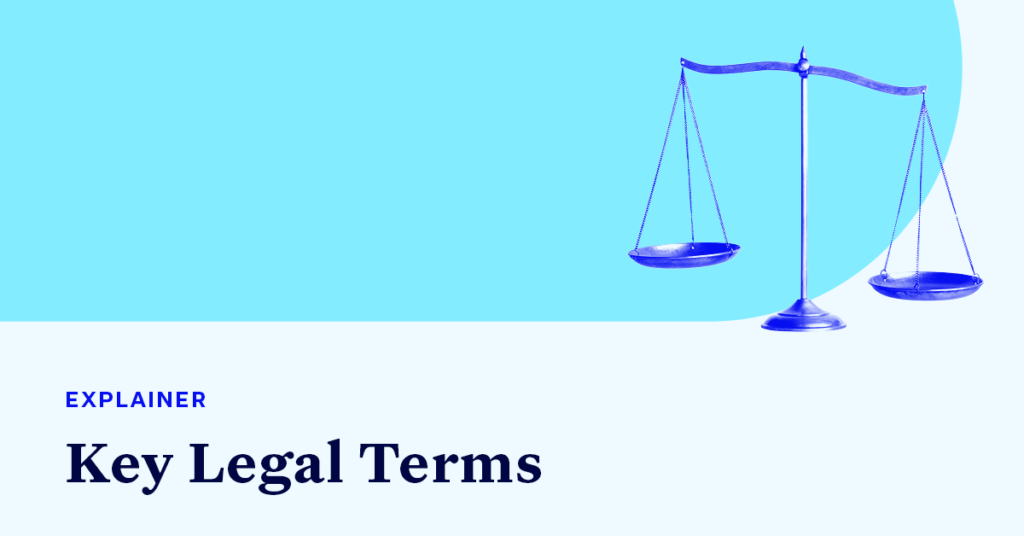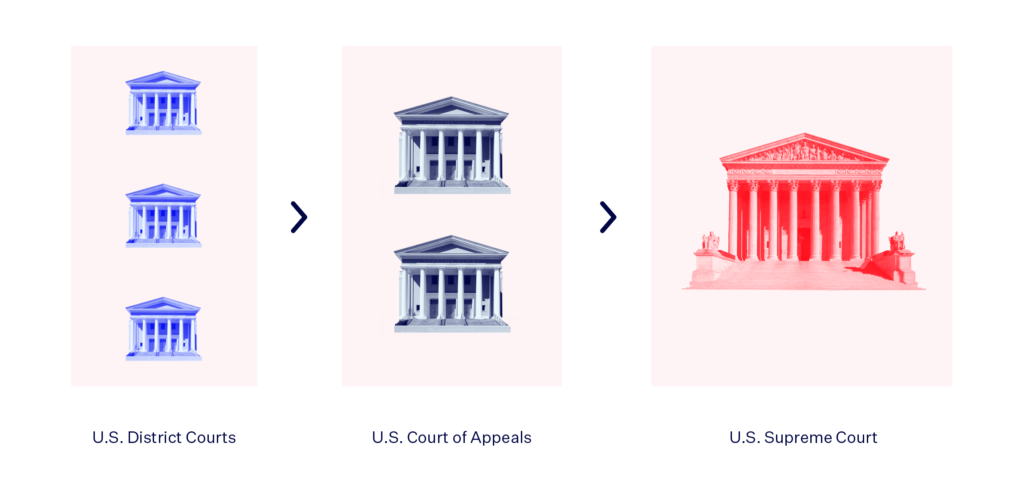Legal Jargon 101

When you visit Democracy Docket’s website, you’ll see a ton of information about ongoing and past litigation around the right to vote. Courts hold immense power when it comes to determining who can vote, how they can vote and how their vote is counted, so it’s important to stay up to date on what is happening in the legal world. However, there are many terms that are unique to the legal profession, which can make it hard to follow along. In today’s Explainer, we define legal terms and phrases you will see throughout our website. Once you’re done brushing up on voting rights legalese, head over to our Cases pages, where we track all-important voting rights litigation.
Where the litigating happens:
Voting rights cases can be filed in federal or state court. In federal court, a case starts in a U.S. district court. If a participant in the case disagrees with a decision at the district court level, they can appeal it to a U.S. court of appeals. In redistricting cases alleging constitutional violations, however, the case will go straight to the U.S. Supreme Court. The last possible step in a voting rights case is petitioning the U.S. Supreme Court to hear the case. State courts also have a similar structure.

Who’s who?
Each court level in a voting rights case has different names for the parties, i.e. the participants involved in the case.
In a district court, a case name is listed as Plaintiff(s) v. Defendant(s).
- Plaintiff: An individual or group who files a case in a court asking for a legal remedy.
- Defendant: An individual or group who has to defend themselves in court after a plaintiff files a case against them.
In a court of appeals, the case name is listed as Appellant(s) v. Appellee(s).
- Appellant: The party that lost in the trial court and asks a higher court to reverse or change the lower court’s decision.
- Appellee: The party that won in the trial court and wants the trial court’s decision to stay the same.
In the U.S. Supreme Court, the case name is listed as Petitioner(s) v. Respondent(s).
- Petitioner: The party that lost in the appellate court and asks the Supreme Court to reverse or change the lower court’s decision. The request to have a case reviewed by the Supreme Court is called a petition for certiorari or cert petition. In general, the Supreme Court decides which cases it will hear. So, for a petitioner’s case to be heard, the Supreme Court must agree to hear the case (also known as granting the cert petition).
- Respondent: The party that won in the lower court and wants the lower court’s decision affirmed by the Supreme Court.
Terms you should know:
The list below outlines some words and phrases that you will see throughout our website.
- Affirm: When a higher court agrees with the decision of the lower court.
- Here is an example where a federal court of appeals affirmed the district court’s decision to dismiss the case.
- Bench trial: A trial conducted by a judge without a jury. Almost all voting rights cases that go to trial are bench trials as they are often more efficient (and defendants in civil cases are not entitled to a jury trial if the case does not involve monetary damages).
- Complaint: This is the first document filed in a civil case. It begins the case, names the parties involved and lays out the claim(s) against the defendants.
- This complaint filed in New York challenges the state’s line-warming ban. It was brought against various New York election officials and argues that the state’s law banning line warming at polling places violates the First and 14th Amendments.
- Dismissed with prejudice: If a case is dismissed with prejudice, that means the case is thrown out and parties cannot file an identical lawsuit in the future.
- In Georgia, for example, a lawsuit challenging the inclusion of absentee ballots in the general election results of Georgia was filed by allies of former president Donald Trump. The case was eventually dismissed with prejudice, meaning that the plaintiffs cannot try to file the same case again and start the process over from scratch.
- Dismissed without prejudice: If a case is dismissed without prejudice, that means the parties who brought the case can file a similar (or even identical) lawsuit again. This gives the parties a chance to address the defects in their complaint that caused it to be thrown out and refile a similar case with the same claims.
- Injunction: A court order stopping one or more defendants from taking a specific action. In voting rights cases, a preliminary injunction is often sought so that harmful laws cannot be enforced while the case moves through the courts. A permanent injunction can be issued by the court if it is determined that a part or all of a law cannot stand.
- For instance, in a recent case in a North Carolina state court, a preliminary injunction was issued blocking a strict photo ID law from being enforced while the case went to trial. After the trial, a majority of a three-judge panel issued a permanent injunction after it held that the challenged law was unconstitutional and could not stand.
- Jurisdiction: A court’s authority to hear cases and make legal decisions. You will often see jurisdiction used as shorthand to reference the geographical scope of a court’s authority, but there are a few different categories of jurisdiction. For voting rights cases, pay particular attention to subject-matter jurisdiction — whether the court has the ability to adjudicate, or judge, the specific claim brought before it. If it doesn’t have subject matter jurisdiction, that claim is dismissed.
- In particular, a Wisconsin federal court found that it did not have subject matter jurisdiction over a lawsuit brought by Trump seeking to decertify the 2020 general election results in Wisconsin because the plaintiffs did not have a legal right to bring the case in the first place. This meant that the court did not have authority to rule on the actual merits of the case, and the case was dismissed.
- Moot: The issue at the center of a case is moot if it is not “live” — meaning the controversy has not yet taken place or it has stopped and therefore there is no actual dispute for the court to resolve.
- For example, a case challenging a certain voting procedure would become moot if a law is passed that addresses the defects in the voting procedures — here’s a real-life example from the state of Florida.
- Remand: When a higher court sends a case back to the lower court in order for the lower court to take further action. A remand is often tied to a reversal (see below) and can lay out specific instructions for the lower court to follow, such as instructing it to dismiss the case.
- Reverse: When a higher court disagrees with the decision of the lower court.
- Here’s an instance where a federal court of appeals disagreed with the district court’s decision and reversed the holding of the lower court.
- Settlement: When parties agree to end their case before conducting a trial. A settlement will spell out legal requirements of the parties and may involve monetary payments to end a case. Most cases end with a settlement — litigation is an expensive ordeal that parties want to avoid when possible. However, voting rights cases often go to trial since the defendants generally want restrictive voting laws to remain in place.
- Recently, a settlement in Texas led to the expansion of voter registration opportunities.
Motions to look out for:
A motion is a formal request on behalf of a party that asks the court to decide on an issue relating to a case. In voting rights litigation, you will most commonly see the following motions.
- Motion to intervene: When an outside group(s) asks to join a case as either a plaintiff or defendant. The intervening party believes they will be directly affected by the case and bring a new perspective that the other existing parties do not. In voting rights cases, Democratic and Republican party committees will often intervene to either protect or attack voting laws.
- For example, Republicans have intervened in every lawsuit challenging Georgia’s new voter suppression law, Senate Bill 202, because they have a vested interest in keeping the law in place.
- Motion to dismiss: When the defendant(s) ask the judge to throw out a case or part of a case, arguing that there is a defect with the complaint. A motion to dismiss is filed by a defendant at the start of a case’s life cycle, before all of the claims are litigated in court. If a court grants a motion to dismiss (such as in this case), it agrees with the defendants that there is a fatal flaw with the complaint and the case cannot continue.
- Motion for summary judgment: When one party asks the judge to rule on a portion or all of a case without a full trial by arguing and presenting evidence that their side is right. If granted, the judge will enter judgment in favor of one party and against the other party.
- For example, if a court determines that, given all the information presented in a case thus far, none of the facts can be disputed over whether a particular voting law disenfranchises a certain class of voters (here is a real-life example), it will enter judgment in favor of the plaintiffs seeking to block that law. Because the facts are undisputed, there is no need to debate the merits of that allegation at trial, so the court can rule on it.
- Motion to stay pending appeal: When a party appealing a lower court’s decision asks the higher court judge to stay (meaning “pause”) the effect of a lower court’s ruling while the case is on appeal. This is especially important in voting rights cases where the impact of an order can be immediately felt if not stayed. The reverse can also happen where a voting rights victory is stayed pending appeal, leaving a harmful law or practice in place in the interim.
- This happened in Texas during the 2020 election cycle when a district court’s order blocking the closure of additional drop boxes was stayed pending appeal, which allowed the ban on additional drop boxes to remain in place during the November 2020 election.
Litigation protecting the right to vote is crucial to our democracy. Keep an eye on Democracy Docket’s website for all-things voting rights in the courts.